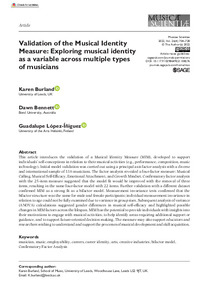Validation of the Musical Identity Measure : Exploring musical identity as a variable across multiple types of musicians
Burland, Karen; Bennett, Dawn; López-Íñiguez, Guadalupe (2022)
Lataukset:
Burland, Karen
Bennett, Dawn
López-Íñiguez, Guadalupe
SAGE
2022
2045-4147
Burland, K., Bennett, D., & López-Íñiguez, G. (2022). Validation of the Musical Identity Measure: Exploring musical identity as a variable across multiple types of musicians. Musicae Scientiae, 26(4), 704–728. https://doi.org/10.1177/10298649221108576
lehtiartikkeli
Julkaisun pysyvä osoite on
https://urn.fi/URN:NBN:fi-fe202301051576
https://urn.fi/URN:NBN:fi-fe202301051576
Tiivistelmä
This article introduces the validation of a Musical Identity Measure (MIM), developed to support individuals’ self-conceptions in relation to their musical activities (e.g., performance, composition, music technology). Initial model validation was carried out using a principal axis factor analysis with a diverse and international sample of 336 musicians. The factor analysis revealed a four-factor measure: Musical Calling, Musical Self-Efficacy, Emotional Attachment, and Growth Mindset. Confirmatory factor analysis with the 25-item measure suggested that the model fit would be improved with the removal of three items, resulting in the same four-factor model with 22 items. Further validation with a different dataset confirmed MIM as a strong fit as a bifactor model. Measurement invariance tests confirmed that the bifactor structure was the same for male and female participants; individual measurement invariance in relation to age could not be fully examined due to variance in group sizes. Subsequent analysis of variance (ANOVA) calculations suggested gender differences in musical self-efficacy and highlighted possible changes in MIM factors across the lifespan. MIM has the potential to provide individuals with insights into their motivations to engage with musical activities, to help identify areas requiring additional support or guidance, and to support future-oriented decision making. The measure may also support educators and researchers wishing to understand and support the processes of musical development and skill acquisition.
